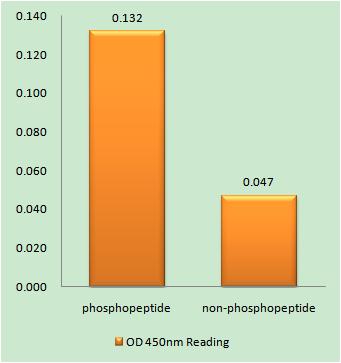NFATc4 (phospho Ser168/S170) Polyclonal Antibody
- Catalog No.:YP1104
- Applications:WB;IHC;IF;ELISA
- Reactivity:Human;Mouse
- Target:
- NFAT3
- Fields:
- >>cGMP-PKG signaling pathway;>>Cellular senescence;>>Wnt signaling pathway;>>Axon guidance;>>C-type lectin receptor signaling pathway;>>Oxytocin signaling pathway;>>Hepatitis B;>>Human cytomegalovirus infection;>>Human T-cell leukemia virus 1 infection;>>Kaposi sarcoma-associated herpesvirus infection;>>Human immunodeficiency virus 1 infection
- Gene Name:
- NFATC4
- Protein Name:
- Nuclear factor of activated T-cells cytoplasmic 4
- Human Gene Id:
- 4776
- Human Swiss Prot No:
- Q14934
- Mouse Gene Id:
- 73181
- Mouse Swiss Prot No:
- Q8K120
- Immunogen:
- The antiserum was produced against synthesized peptide derived from human NFAT3 around the phosphorylation site of Ser168 and Ser170. AA range:136-185
- Specificity:
- Phospho-NFATc4 (S168/S170) Polyclonal Antibody detects endogenous levels of NFATc4 protein only when phosphorylated at S168/S170.
- Formulation:
- Liquid in PBS containing 50% glycerol, 0.5% BSA and 0.02% sodium azide.
- Source:
- Polyclonal, Rabbit,IgG
- Dilution:
- WB 1:500 - 1:2000. IHC 1:100 - 1:300. ELISA: 1:5000.. IF 1:50-200
- Purification:
- The antibody was affinity-purified from rabbit antiserum by affinity-chromatography using epitope-specific immunogen.
- Concentration:
- 1 mg/ml
- Storage Stability:
- -15°C to -25°C/1 year(Do not lower than -25°C)
- Other Name:
- NFATC4;NFAT3;Nuclear factor of activated T-cells; cytoplasmic 4;NF-ATc4;NFATc4;T-cell transcription factor NFAT3;NF-AT3
- Observed Band(KD):
- 140kD
- Background:
- This gene encodes a member of the nuclear factor of activated T cells (NFAT) protein family. The encoded protein is part of a DNA-binding transcription complex. This complex consists of at least two components: a preexisting cytosolic component that translocates to the nucleus upon T cell receptor stimulation and an inducible nuclear component. NFAT proteins are activated by the calmodulin-dependent phosphatase, calcineurin. The encoded protein plays a role in the inducible expression of cytokine genes in T cells, especially in the induction of interleukin-2 and interleukin-4. Alternative splicing results in multiple transcript variants. [provided by RefSeq, Jan 2014],
- Function:
- domain:Rel Similarity Domain (RSD) allows DNA-binding and cooperative interactions with AP1 factors.,function:Plays a role in the inducible expression of cytokine genes in T-cells, especially in the induction of the IL-2 and IL-4. Transcriptionally repressed by estrogen receptors; this inhibition is further enhanced by estrogen. Increases the transcriptional activity of PPARG and has a direct role in adipocyte differentiation. May play an important role in myotube differentiation. May play a critical role in cardiac development and hypertrophy. May play a role in deafferentation-induced apoptosis of sensory neurons.,PTM:Phosphorylated by NFATC-kinases; dephosphorylated by calcineurin. Phosphorylated on Ser-168 and Ser-170 by FRAP1, IRAK1, MAPK7 and MAPK14, on Ser-213 and Ser-217 by MAPK8 and MAPK9, and on Ser-289 and Ser-344 by RPS6KA3. Phosphorylated by GSK3B.,PTM:Ubiquitinated, leading
- Subcellular Location:
- Cytoplasm, cytosol . Nucleus . When hyperphosphorylated, localizes in the cytosol. When intracellular Ca(2+) levels increase, dephosphorylation by calcineurin/PPP3CA leads to translocation into the nucleus (PubMed:11997522, PubMed:18347059). MAPK7/ERK5 and MTOR regulate NFATC4 nuclear export through phosphorylation at Ser-168 and Ser-170 (PubMed:18347059). .
- Expression:
- Widely expressed, with high levels in placenta, lung, kidney, testis and ovary (PubMed:18675896). Weakly expressed in spleen and thymus (PubMed:18675896). In the hippocampus, expressed in the granular layer of the dentate gyrus, in the pyramidal neurons of CA3 region, and in the hippocampal fissure (PubMed:18675896). Expressed in the heart (at protein level) (PubMed:12370307).
- June 19-2018
- WESTERN IMMUNOBLOTTING PROTOCOL
- June 19-2018
- IMMUNOHISTOCHEMISTRY-PARAFFIN PROTOCOL
- June 19-2018
- IMMUNOFLUORESCENCE PROTOCOL
- September 08-2020
- FLOW-CYTOMEYRT-PROTOCOL
- May 20-2022
- Cell-Based ELISA│解您多样本WB检测之困扰
- July 13-2018
- CELL-BASED-ELISA-PROTOCOL-FOR-ACETYL-PROTEIN
- July 13-2018
- CELL-BASED-ELISA-PROTOCOL-FOR-PHOSPHO-PROTEIN
- July 13-2018
- Antibody-FAQs
- Products Images

- Enzyme-Linked Immunosorbent Assay (Phospho-ELISA) for Immunogen Phosphopeptide (Phospho-left) and Non-Phosphopeptide (Phospho-right), using NFAT3 (Phospho-Ser168+Ser170) Antibody

- Immunohistochemistry analysis of paraffin-embedded human breast carcinoma, using NFAT3 (Phospho-Ser168+Ser170) Antibody. The picture on the right is blocked with the phospho peptide.

- Western blot analysis of NFAT3 (Phospho-Ser168+Ser170) Antibody. The lane on the right is blocked with the NFAT3 (Phospho-Ser168+Ser170) peptide.



